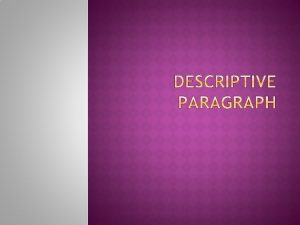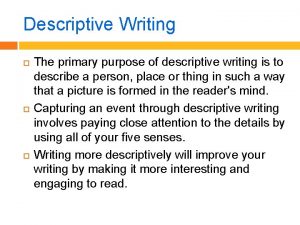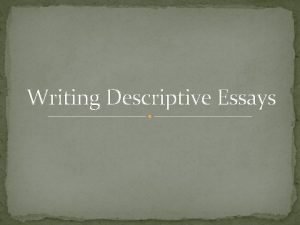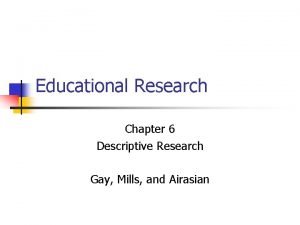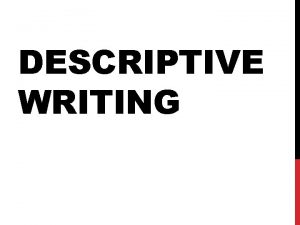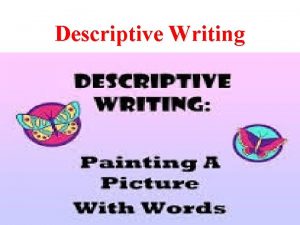The purpose of descriptive writing is to make





- Slides: 5


� The purpose of descriptive writing is to make our readers see, feel, and hear what we have seen, felt, and heard. Whether we're describing a person, a place, or a thing, our aim is to reveal a subject through vivid and carefully selected details.

Preferably, description paragraphs should concentrate on action (verbs), rather than sensations (adverbs and adjectives). Writers should assume the role of readers whose idea of the described events is, in entirety, constructed by the paragraph content. Description paragraphs should be detailed, clear, and render the represented reality chronologically. Rather than providing advice, descriptive paragraphs ought to focus on essential information that is presented in a step-by-step manner.

� Descriptive paragraphs contain the following elements: � Information – descriptive paragraphs describe ideas and things, as well as inform about their functions; � Context – in descriptive paragraphs, information is always contextualized. Moreover, the context in which given piece of information is presented is also subject to description and evaluation; � Descriptive language – descriptive paragraphs use considerable amounts of vocabulary that describes action (verbs), as well as vocabulary denoting value and attributes of thins (nouns, adverbs, and adjectives).

On one corner of my dresser sits a smiling toy clown on a tiny unicycle--a gift I received last Christmas from a close friend. The clown's short yellow hair, made of yarn, covers its ears but is parted above the eyes. The blue eyes are outlined in black with thin, dark lashes flowing from the brows. It has cherry-red cheeks, nose, and lips, and its broad grin disappears into the wide, white ruffle around its neck. The clown wears a fluffy, two-tone nylon costume. The left side of the outfit is light blue, and the right side is red. The two colors merge in a dark line that runs down the center of the small outfit. Surrounding its ankles and disguising its long black shoes are big pink bows. The white spokes on the wheels of the unicycle gather in the center and expand to the black tire so that the wheel somewhat resembles the inner half of a grapefruit. The clown and unicycle together stand about a foot high. As a cherished gift from my good friend Tran, this colorful figure greets me with a smile every time I enter my room.
